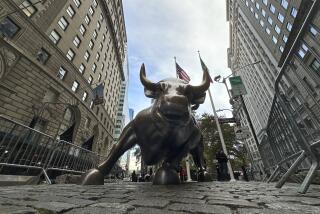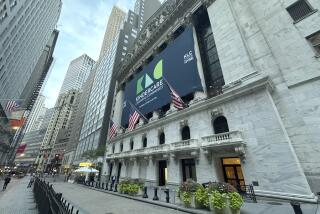Dow Suffers Record Loss-- 45.75 Points
NEW YORK — The Dow Jones industrial average suffered its biggest one-day loss in history Monday, a resounding 45.75-point fall provoked by the absence of any clear signs of an economic upturn and magnified by computerized stock-selling programs.
It was the closely watched indicator’s third record drop this year, after declines of 39.10 on Jan. 8 and 41.91 points on April 30. In percentage terms, the Dow’s 2.43% fall Monday was dwarfed by the 38.33-point, or 12.8%, loss on “Black Monday,” Oct. 28, 1929, because the average is much higher now. Duplicating that percentage decline today would require a fall of 241 points.
The Dow index opened Monday’s trading down more than 13 points from Friday’s close and, in the words of S. Richard Szczepanik, a partner in Harvard Management Co., manager of Harvard University’s $4-billion endowment fund, the index “cascaded” during the day.
Although many professionals blamed the magnitude of Monday’s fall on computerized “program trading,” the now-ubiquitous system in which large transactions are triggered by price disparities between stocks and stock-index futures, most observed that the market was due for a reversal in any event because of its strong rise of more than 125 points over the last three weeks.
The Dow index--down to 1,758.18 on May 19--closed Friday at a record high of 1,885.90 and finished Monday at 1,840.15.
“All the financial markets have been very nervous, in part because of their tremendous run-up,” said Allen Sinai, chief economist at the investment firm of Shearson Lehman Bros. “For the stock market, the actual performance of the American economy doesn’t show, in growth or corporate earnings, the strength that has been anticipated.”
Monday’s collapse was a broad one. All major market indexes dropped sharply, with Standard & Poor’s 500-stock index falling 5.71 points to 239.96 and the New York Stock Exchange composite index falling 2.95 to 138.03.
Declining stocks outnumbered advances by 1,416 to 265; not one of the 30 stocks in the Dow industrial index rose, and only one remained unchanged.
The general feeling that the economy remains listless gained credence from the government’s latest unemployment report, released Friday. The Labor Department reported an increase in civilian unemployment to 7.3% in May from 7.1% in April, with weakness showing particularly in the manufacturing sector.
In past months, such economic languor would have been likely to provoke a stock rally because of expectations that the Federal Reserve Board would ease credit to stimulate growth. The consequent reduction in interest rates would drive investment money out of bonds, bank deposits and money market accounts and into the stock market.
Impact of Lower Rates
But now, the Fed’s principal concern appears to be the impact of lower rates on the falling dollar. If interest rates fall, investment in the United States becomes less attractive to foreigners, the relative value of the dollar falls further and the price of imports rises, increasing the inflation rate.
“The Fed is reluctant to ease credit over concerns about what the lower dollar will do to inflation later on,” Sinai said. “The Fed is hamstrung.”
Thus, stock traders have become concerned that they may have bid stock prices up too high with further interest-rate cuts appearing unlikely and corporate earnings lagging.
With the economy in transition from a weak economy to a strong one, Sinai added, “we’re in a no man’s land in which program trading can have a major impact” on the market.
Such trading has contributed to 1986’s status as a year of extremes. The year has seen not only the three record one-day losses in the Dow industrial average, but also the second- and third-largest one-day gains--41.30 points on March 11 and 39.03 points three days later.
Still, program trading could not account for all of Monday’s comprehensive sell-off. “The market was technically set up for a day like this,” said Szczepanik, who conducts the program arbitrage for the Harvard fund.
Added Robert Nurock, a widely followed investment adviser and publisher of The Astute Investor, a Paoli, Pa., newsletter, “The weakness suggests there’s more than the programs at work.”
Computerized program trading works by matching purchases of select groups of stocks with sales of corresponding stock-index futures. When the futures sell at a lower price than the stocks, traders automatically sell the stocks and buy the futures, guaranteeing themselves a profit equivalent to the “spread” between the prices. The system also works in reverse, when the futures trade higher than the stocks and investors buy the stocks and sell the futures.
More to Read
Inside the business of entertainment
The Wide Shot brings you news, analysis and insights on everything from streaming wars to production — and what it all means for the future.
You may occasionally receive promotional content from the Los Angeles Times.










